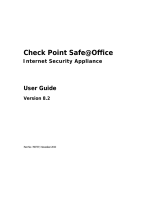
VSX High Availability ..........................................................................................85
VSX Gateway High Availability ......................................................................85
Per Virtual System High Availability ...............................................................85
Virtual System Load Sharing (VSLS) ..................................................................86
Requirements ................................................................................................86
Conceptual Overview .....................................................................................86
Failure Recovery ............................................................................................90
Bridge Mode .......................................................................................................90
Spanning Tree Protocol (STP) Bridge Mode ..................................................90
Active/Standby Bridge Mode ..........................................................................90
Using Virtual Switches in a Cluster .....................................................................92
Managing VSX Clusters ........................................................................................ 93
Configuration Overview ......................................................................................93
Creating a New Cluster ......................................................................................93
Defining Cluster General Properties ...............................................................94
Selecting Creation Templates ........................................................................94
Adding Members ............................................................................................95
Defining Cluster Interfaces .............................................................................96
Configuring Cluster Members ........................................................................97
Cluster Management......................................................................................97
Completing the Wizard ...................................................................................98
Modifying a Cluster Definition .............................................................................98
Modifying Cluster Properties ..........................................................................98
Working with Cluster Members ......................................................................... 107
Adding a New Member ................................................................................ 107
Deleting a Member ...................................................................................... 108
Upgrading Cluster Members ........................................................................ 108
Changing the Cluster Type ............................................................................... 110
Converting from VSLS to High Availability ................................................... 110
Converting from High Availability to VSLS ................................................... 111
Sample Command Output............................................................................ 111
Configuring VSX High Availability ..................................................................... 112
Enabling VSX Gateway High Availability ...................................................... 112
Enabling Per Virtual System High Availability .............................................. 113
Configuring Virtual System Load Sharing ......................................................... 113
Enabling VSLS............................................................................................. 113
Creating a New VSLS Cluster ...................................................................... 114
Using the vsx_util vsls Command ................................................................ 114
Distributing Virtual Systems Amongst Members ........................................... 115
Viewing VSLS Status ................................................................................... 116
Exporting and Importing VSLS Configurations ............................................. 117
Configuring Virtual Systems in Bridge Mode ..................................................... 119
Overview ...................................................................................................... 119
STP Bridge Mode ........................................................................................ 119
Active/Standby Bridge Mode ........................................................................ 121
Advanced Clustering Configuration .................................................................. 122
Clusters on the Same Layer-2 Segment ...................................................... 122
Monitoring all VLANs with ClusterXL ............................................................ 123
Enabling Dynamic Routing Protocols ........................................................... 124
Working with URL Filtering ................................................................................ 126
Introduction ...................................................................................................... 126
Terminology ................................................................................................. 126
Configuring URL Filtering ................................................................................. 127
Enabling URL Filtering ................................................................................. 127
Defining the URL Filtering Policy ................................................................. 127
Updating the Content Inspection Database .................................................. 128
Password Bypass ........................................................................................ 129
URL Filtering Acceleration ........................................................................... 129
Working with Link Aggregation ......................................................................... 130
























